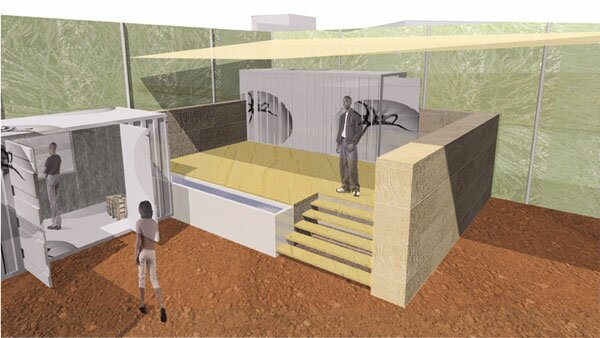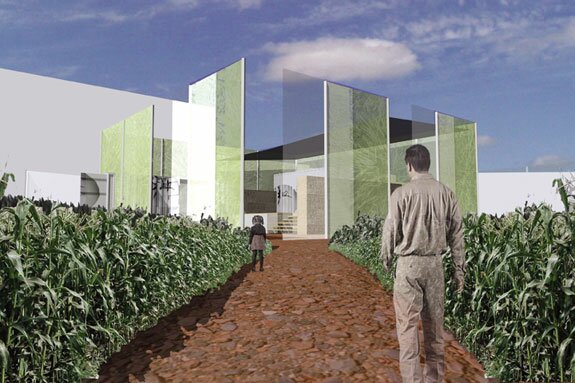 |
 |
| |
Recycling, Renewal, and Radicchio
Ken Dunn and Mobile City Farmstead
by John Hill
Recently Chicago has experienced a surge of architectural hipness, after years of wallowing in mediocrity. International superstars Frank Gehry and Rem Koolhaas have left their mark at Millennium Park and the Illinois Institute of Technology, respectively. Local bad-boy Helmut Jahn has returned from European exile to build an elegant dormitory, also at IIT. But hipper than Gehry, Koolhaas, and Jahn bundled together is sustainability, loosely defined as design that works with the natural environment, considers future generations, and addresses economic, social, and environmental concerns in a sensitive manner.
While this doesn't sound very exciting, architects have latched onto the cause, creating some of the most beautiful architecture in recent years, including Norman Foster's Commerzbank and Gherkin towers in Europe, Renzo Piano's Jean-Marie Tjibaou Cultural Center in Asia, and Behnisch, Behnisch & Partner's Genzyme Center in Cambridge, Massachusetts. Likewise, Chicago's Mayor, Richard M. Daley, has latched on to sustainability, assuredly stating that the Midwestern city will be the greenest in the United States. Littering sidewalks and parkways with trees, putting green roofs on Loop high-rises, creating the Chicago Center for Green Technology, and recently holding an international design competition for the Ford Calumet Environmental Center, the Boss is realizing his goal one piece at a time.

Rendered view of Mobile City Farmstead's porch and workspace.
One important piece in this picture, though not affiliated with the City of Chicago, is Resource Center, a not-for-profit environmental organization headed by Ken Dunn. With recycling, composting, and educational programs, Dunn's scope appears to extend beyond the Mayor's mission, particularly in his quest to change the way we grow and consume our food. "We're trying to be sustainable in other ways," Dunn says, "beyond merely organic means." Through architecture he's found a way to further his ambitious agenda, but first some words on one of the Center's programs.
Resource Center's City Farm fills a vacant lot near the corner of Division and Clybourn, between Cabrini-Green public housing to the west, and the Old Town and Gold Coast neighborhoods to the east. On the large lot, Dunn harvests some of the most delicious vegetables you'll ever eat, including beets, carrots, potatoes, lettuce, and tomatoes, selling them to high-end restaurants like Frontera Grill, North Pond, and the Ritz-Carlton Dining Room. Through this effort, he grows the produce organically and sells it for local consumption, a rarity in this age of large-scale agri-business and packaged foods. Dunn explains, "We want to get everybody used to food grown in the city, creating a sustainable culture but also a sustainable economy, by employing the unemployable and possibly homeless people."
To physically achieve this program, Dunn leases vacant lots around the city (four separate City Farms at the time of writing, but with over 80,000 vacant lots in Chicago, there's no shortage for his needs), lays down a protective clay barrier if required, brings in fresh soil and compost from his other sites and programs, and farms the land until it's sold for redevelopment. This transient existence helps to beautify the vacant patches around the city, while at the same time being a viable use for the land and creating jobs for the local communities.
Architecture came into play in early 2003, when four employees of local architecture firms DeStefano + Partners and Valerio DeWalt Train, Matthew Kuhl, Karin Lucas, Dan Rappel, Amy Struckmeyer, and Shwetha Subramanian, attended a one-day urban gardening workshop, or charette, at the Chicago Center for Green Technology. There they met Ken Dunn and learned about his ambitious programs. "I was struck by the clarity and simplicity of his ideas," says Kuhl. "What's exciting about Ken's program is that he plants his farm where it's least expected, in some of the most derelict spaces in the city," Lucas adds. "He moves in topsoil and plants and transforms vacant city lots nearly overnight."
Months later, when the First Annual Chicago Sustainable Design Challenge was organized by the Foresight Design Initiative (a local chapter of the o2 Global Network), they reunited with Dunn to create the Mobile City Farmstead. "We discussed a number of potential ideas but Ken's farm seemed the most promising," explains Rappel, adding that "we were a bit nervous Ken wouldn't like our design, but he ended up loving it." The entry went on to win the Design Challenge's Award for Design Excellence.
The Mobile City Farmstead will be the focus of City Farm's site at Division and Clybourn, creating an identity for Dunn's program and a physical anchor for the site. It will provide a gathering area, workspace, restroom, and small produce stand. The Farmstead will also provide a place from which to conduct classes, tours, and gatherings, such as the annual Slow Food Urban Harvest held in the autumn. Beyond the Division and Clybourn site, the Farmstead will become a prototypical design that can be transported easily to other sites across the city. Ideally, multiple ones will sprout up throughout Chicago.
So where's the hipness? It lies in the architectural components and their relationship to City Farm's overreaching ideas. Most apparent are two reused shipping containers. One contains office space, while the other provides storage space and acts as the produce stand. Each is emblazoned with super-graphics, images of tomatoes enlarged greater than human size. New openings for access and the produce stand's retail window are made via welding the container. These relatively cheap ($1,500 a piece) containers give the project its primary identity, an industrial aesthetic that fits at home in most city sites. "Using shipping containers was really a no-brainer," says Rappel, "due to them being transportable, weatherproof, and relatively cheap." By reusing them, the architects are also relating to one of Dunn's other programs, recycling.
The architects found inspiration in the work of LOT/EK, a New York-based architecture studio that investigates the reuse of outdated industrial objects for contemporary uses, such as a loft where residents sleep in a refashioned petroleum trailer tank. With the shipping containers, the architects found a functional object that also symbolizes City Farm's transient nature, similarly evident in Australian architect Sean Godsell's Future Shack, his prototypical housing for disaster victims that uses shipping containers as temporary homes. Another reference is the late Samuel Mockbee's Rural Studio in Alabama, where his students recycled everything from carpets to car windshields for homes and other buildings for the rural poor. "We're taking an object that's become an almost disposable commodity," explains Kuhl. It appears that the Farmstead architects are using industrial components as a way to salvage the excesses of globalization, but also as creative inspiration and a way to brand City Farm in the urban environment.
At Division and Clybourn, the two shipping containers start to define the area of the Farmstead, further delineated by vine-covered chain-link fencing and straw bales (although used in the original competition design, at the time of writing the architects were considering bundling non-combustible paper used by Blue Man Group or breaking down and reusing wood palettes, objects that are as ubiquitous as shipping containers). Additionally, a canvas covering provides shade while funneling rainwater towards a collecting basin, where the water can then be used for washing vegetables at the outdoor work area.

Rendering of Mobile City Farmstead from the City Farm.
What all these components (shipping containers, chain-link fencing, bales, canvas) have in common is their thrift, as well as being degradable, salvageable, and transportable. If all goes to plan, and the Farmstead is completed in Fall 2004 or Spring 2005, the Division and Clybourn site will be only the first of many sites where the Farmstead will find a home. Sized to the minimum requirements for a viable City Farm (approximately half an acre), the Farmstead is designed to be relocated quickly, particularly when the soon-to-be neighboring single-room occupancy apartments for low-income and homeless residents (developed by Lakefront Supportive Housing and designed by Helmut Jahn) go ahead with Phase 2 plans that will construct additional apartments on the corner site. Recently visiting the site with the architects and Dunn, I learned that the first phase of the SRO taking place of the current City Farm, which eventually relocates to Ohio and Larabee, will impact the Farmstead's initial site plan, but that didn't faze either party. "We originally designed the Farmstead to be next to the alley, for vehicle access and loading," recounts Struckmeyer. "By moving the Farmstead south and rotating it, we addressed concerns of access during construction next door," she continues, "I think it will work just as well in its new location, and having it right on Clybourn may even give the whole project more prominence." Change is an integral component of the architectural process, the design, and City Farm's existence, making this maneuver indicative of the Farmstead design's malleability that will help make it suitable on other sites around the city.
While the Farmstead's design, and its sustainable components, may make it unintentionally hip, it also embodies romantic notions, owing to Dunn's City Farm and its methods and goals. City Farm returns us to an era when people ate locally what was grown locally. Aiming for the same scenario today gives us fresher, organic foods, but also has the effect of beautifying our surroundings while serving greater cultural and economic needs and promoting a climate of sustainability in Chicago.
|
|
|